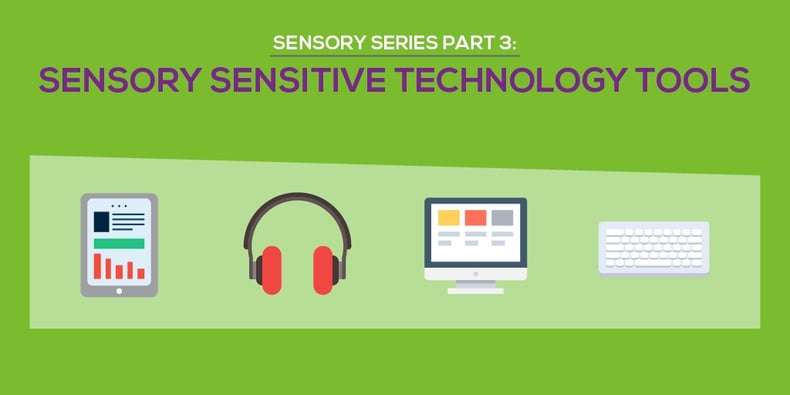
In the previous two Sensory Series posts, we covered meeting the sensory needs of students and designing a sensory sensitive classroom. The final piece of the sensory puzzle is how devices can assist students in the classroom. Can technology help students with sensory issues? And can it impede their learning if we aren’t attentive to their needs?
These are questions that teams ask one another every day in schools. We know that technology can be a great accelerator for learning at times, but for students with sensory input issues or a sensory processing disorder, technology can be a hinderance as well. It takes patience and consideration, along with great collaboration, to make sure technology helps a student further their education.
Adaptive and Assistive Technology
Let’s start by looking at how technology can help students with special needs—in particular, students with sensory needs. The broad term for technology that is used to support students with special needs or disabilities is “adaptive technology.” This term is a catch-all for a lot of different supports for students, from physical and mental supports to communication supports. As teachers consider how to meet the needs of their students, adaptive technology is an area that should be considered.
For further information about this topic, teachers can reference Living in the State of Stuck to get a primer on adaptive and assistive technology. Here is another overview of the different considerations that teachers and special education providers consider when working with students. These are great starting points for teachers, teams, or parents to explore how technology can work to support their student.
Some students on the autism spectrum rely heavily on assistive technology to communicate. These students can be trained to be fluent with their communication through the use of a “talker” or a device that will speak for them. These are great tools that can demonstrate how much intelligence students with autism truly have, even though they don’t have the capability to “get it out” through speech.
Supporting Learners With Differing Needs
What about those students who are not “assisted” by technology, and have a negative reaction to it for whatever reason? How can teachers handle these situations?
Let’s consider some of the sensory areas to think about how technology may be adapted to help support these learners:
Sight: To meet the needs of students with vision sensory issues, teachers can try to adjust brightness, color and/or size of text, and the style of font. At times, reading a device may be challenging for a student with autism or a sensory processing disorder, so an easy accommodation could be printing the material for the student. The type of device may also play a role in this decision—the student may work better with a larger monitor or bigger laptop compared to a Chromebook or iPad.
Hearing: When it comes to the sounds of technology, the volume and kinds of sounds are the first considerations. Headphones would be something worth trying—some students do well with them, while others do not (because of tactile sensory issues). For many computer games, the sound can be muted if it isn’t essential to the learning.
Touch: With tablet devices being pretty pervasive, the “touch” of technology matters a lot for students. Depending on how the student is learning to keyboard, a flat glass tablet screen may be perfect. On the other hand, if a student struggles with that, a physical keyboard could be a perfect fit. Be sure to explore with the student how it feels to their hands and how the sound of the keys may affect them as well. Also, consider how a student will handle a touch board. These can be great tools for students who need to move around the room and those who need to touch and feel.
Writing: Even though this isn’t one of the five senses, there is such a complexity to writing that it is important to stop and consider. The feel of the pencil or pencil grip and the sound of the writing on the paper or desk are both types of sensory input that students may have opinions about. Graphic organizers can be great tools for visual organization—teachers should keep in mind the size of the graphics, lines for sight, etc. when using these.
One of our end goals in education is always to create independence for our students. For those students who are older and capable, we should train them on how to make these technology adjustments for themselves. Then in the future, regardless of the context, students can meet their own needs as much as they are able to.
This isn’t the comprehensive list of all things to consider for adaptive technology, but it may be a starting point for a teacher to try to adjust and adapt to meet the needs of their sensory sensitive learners. Want to learn more about the MimioTouch touch board? Check it out here. And for more teaching tips, tools, and the latest information on the world of education, be sure to subscribe to the Mimio Educator blog today!



